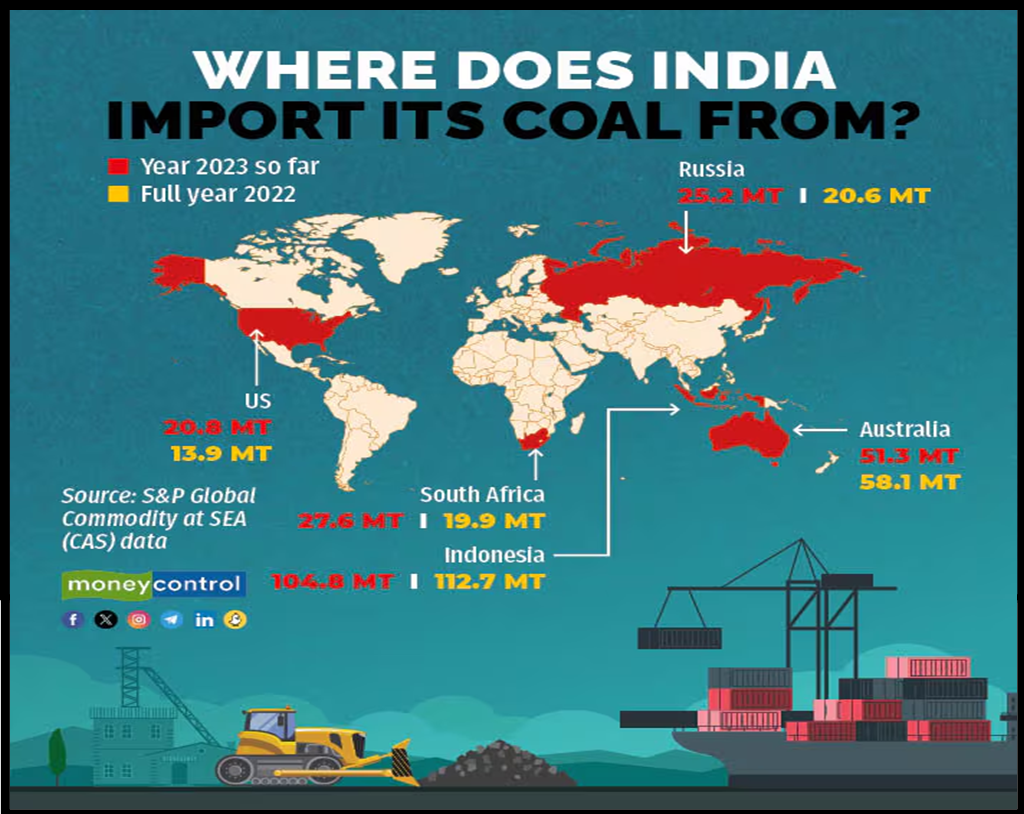UNDERSTANDING INDIA’S COAL IMPORTS
Syllabus:
GS-III
- Infrastructure: Energy, Ports, Roads, Airports, Railways etc.
- Conservation, Environmental Pollution and Degradation, Environmental Impact Assessment.
Why in the news?
India’s coal imports scrutinised amid electricity shortages, highlighting logistical challenges and misconceptions regarding alternative sourcing.
Source:wordpress
Highlights of the logistical challenges of Coal:
- India faces electricity shortages due to unpredictable weather patterns and a growing economy.
- Domestic thermal coal shortages contribute to electricity scarcity.
- The discourse on coal imports warrants scrutiny for accurate understanding and effective solutions.
About the Import of Coal:
- Coal can be freely imported by consumers under Open General License based on their commercial needs.
- Steel manufacturing units like Steel Authority of India Limited (SAIL) import coking coal to bridge the gap between demand and domestic supply and enhance production quality.
- Non-coking coal is imported by coal-based power plants, cement plants, captive power plants, sponge iron plants, industrial consumers, and coal traders.
- Coke is mainly imported by pig-iron manufacturers and consumers in the iron & steel sector using mini-blast furnaces.
- Import details of coal and related products like coke for the last six years are available.
| Understandind Classification of Coal:
Origin: ● Coal originates from the transformation of organic matter, primarily wood, buried under sediments. ● Heat and pressure over centuries cause this organic matter to undergo a transformation into coal. Anthracite: ● Highest quality coal with 80 to 95% carbon content. ● Highest calorific value. ● Ignites slowly with a blue flame. ● Found in small quantities in Jammu and Kashmir. Bituminous: ● Contains 60 to 80% carbon content. ● Low moisture content. ● High calorific value. ● Deposits found in Jharkhand, West Bengal, Odisha, Chhattisgarh, and Madhya Pradesh. Lignite: ● Contains 40 to 55% carbon content. ● Often brown in colour with high moisture content. ● Produces smoke when burnt. ● Deposits found in Rajasthan, Lakhimpur (Assam), and Tamil Nadu. Peat: ● First stage of coal formation with less than 40% carbon content. ● Low calorific value. ● Represents early transformation from wood to coal. About Coal Resources in India: ● Geological Resources: Exploration up to a depth of 1200 metres has estimated a cumulative total of 319.02 billion tonnes of coal resources in India as of April 2018. ● Distribution of Hard Coal: Hard coal deposits are spread across 27 major coalfields, primarily concentrated in the eastern and south-central regions of the country. ● Lignite Reserves: Lignite reserves amount to approximately 36 billion tonnes, with 90% of these reserves located in the southern state of Tamil Nadu. Top 5 States by Coal Reserves: ● JharkhandOdisha ● Chhattisgarh ● West Bengal ● Madhya Pradesh |
About Government Initiatives:
- UTTAM Application Launch (April 2018):
- The Ministry of Coal launched the UTTAM (Unlocking Transparency by Third Party
- Assessment of Mined Coal) Application for coal quality monitoring.
- Aims to ensure transparency and efficiency in coal quality monitoring, enhancing governance.
- New Coal Linkage Policy Approval by CCEA:
- The Cabinet Committee on Economic Affairs (CCEA) approved a new coal linkage policy.
- Ensures adequate fuel supply to power plants through reverse auction, enhancing organised fuel supply.
- Online Coal Clearances System:
- The Ministry of Coal developed the Online Coal Clearances System.
- Provides single-window access for investors to submit online applications for coal-related permissions and approvals.
- Coal Allocation Monitoring System (CAMS):
- Developed to monitor coal allocation by CIL to States and consumers transparently.
- Tracks allocation from CIL to States, States to SNA, and SNA to consumers.
- Opening of Commercial Coal Mining:
- Indian and foreign companies are allowed to participate in commercial coal mining in the private sector.
- CCEA approved the auction methodology for sale of coal mines/blocks, marking a significant reform in the sector.
- Online Transparent Auction Platform:
- Auction of coal mines/blocks conducted on an online transparent platform.
- Bid parameter: Price offered in Rupees/Tonne, paid to the State government upon actual coal production.
Challenges:
- Acknowledgment of Logistic Challenges:
-
- The Ministry of Power recognizes logistical issues hindering domestic coal supply.
- Alternative Sources Needed:
-
- While logistics improve over time, exploring alternative coal sources becomes essential to manage shortages effectively.
- Coal Import Considerations:
-
- Coal India Ltd. auctions a portion of its production, and imported coal is considered due to logistical constraints and pricing differences.
- Clarification on Advisory:
-
- Ministry clarifies advisory emphasising blending based on requirements, not mandating imports.
- Impact of Mandatory Blending:
-
- Mandating 6% imported coal blending could raise variable costs, impacting electricity rates for consumers.
- Generation and Location Factors:
-
- Proximity to mines affects coal availability, necessitating tailored solutions for plants facing shortages.
Shortage of Domestic Thermal Coal:
- Shortage was55% of demand, manageable with 0.6 million tonnes of domestic coal.
- August 2023 saw a shortage of 840 million units due to poor monsoon, equivalent to55% of demand.
- Despite availability of over 30 million tonnes of coal, logistics issues hindered supply to power plants.
- The Ministry of Power acknowledges logistical constraints on domestic coal supply.
Way Forward:
- Corrective Measures:
- Addressing logistical bottlenecks, exploring cost-effective alternatives, and ensuring consumers aren’t burdened by inefficient procurement strategies are imperative.
- Enhance Offtake Routes:
- Facilitate bulk transportation over long distances with alternative routes, especially with delayed railway projects.
- Revisit Coal Pricing Mechanism:
- Revise pricing mechanism from mined coal grades to grades desired for end use to reflect market demand accurately.
- Improve Access to Finance:
- A competitive coal mining sector enhances access to competitive finance for expansion and modernization.
- Manage Risk Effectively:
- Develop new risk management instruments, contracting methods, and incentives to address sectoral risks effectively.
- Innovative Financing Solutions:
- Introduce creative financing solutions tailored to address challenges in the power sector and support its growth.
Conclusion:
The discourse on India’s coal imports requires clarity and accuracy to address electricity shortages effectively.Logistics improvement, alternative sourcing, and prudent regulatory decisions are essential for sustainable energy management.
Source: The Hindu
Mains Practice Question:
Critically analyse the discourse surrounding coal shortages in India, focusing on the misconceptions regarding the necessity of coal imports. Discuss the fundamental challenges in addressing these shortages and suggest alternative strategies to bridge the gap, considering the implications for electricity consumers and regulatory oversight.





